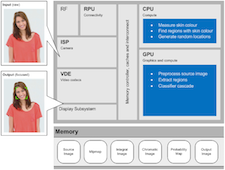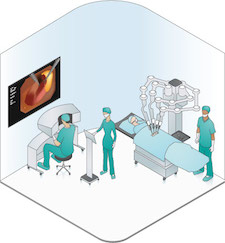|
"Implementing Eye Tracking for Medical, Automotive and Headset Applications," a Presentation from Xilinx and EyeTech Digital Systems
When humans communicate with each other, we get important cues from watching each other’s eyes. Similarly, machines can gain valuable information and new capabilities by detecting and tracking users’ gazes. Robust eye tracking was once limited to cumbersome laboratory set-ups, but today, thanks to improvements in sensors, processors and algorithms, eye tracking can be embedded into a wide range of products such as medical devices, industrial equipment, digital signage and cars. In these applications, eye tracking enables seamless augmented reality, natural user interfaces, and analysis of which objects and information are most interesting to users. In this presentation, Dan Isaacs, Director of Smarter Connected Systems at Xilinx, and Robert Chappell, Founder of EyeTech Digital Systems, present the design of a portable/wearable eye-tracking system. They introduce the fundamental techniques used for eye tracking. They then explore the challenges of implementing robust eye-tracking in a cost- and power-constrained system, and show an innovative design implemented on a programmable SoC that overcomes these challenges. They conclude with a live demo of the eye-tracking system.
"Techniques for Efficient Implementation of Deep Neural Networks," a Presentation from Stanford
Song Han, a graduate student at Stanford, details his latest findings on techniques for the efficient implementation of deep neural networks in this recent presentation.
More Videos
|
|
Implementing Computer Vision with PowerVR: OpenCL Face Detection
Imagination Technologies' R&D group has developed a face detection algorithm based on a classifier cascade and optimized to run on mobile devices comprising a CPU and PowerVR GPU. The algorithm, described in this article from the company, employs several optimizations to improve performance and accuracy. In particular, instead of searching each entire frame for faces, the detector limits its search to regions in which faces were previously detected, plus a few randomly selected regions. Tracking previously-found faces ensures they are not lost, while testing a variety of other regions ensures that new faces are found quickly. More
Medicine with Vision: How Embedded Cameras Benefit Medical Applications
"Cameras long ago secured their place in our daily life," writes Basler in this blog post. "This doesn't just apply to the cameras in our smartphones or the digital cameras we use for vacation snapshots. ATM machines, toll booths, security firms guarding buildings and eye doctors using slit lamps all rely on cameras to perform their jobs. Yet even the most observant of us can easily overlook the majority of the devices, because they involve very small cameras used in embedded systems. Medicine and research in particular require cameras that perform well day after day in the important work being done by and for scientists, physicians, nurses and patients, all without ever drawing the focus to themselves." More
More Articles
|
|
ARM Guide to OpenCL Optimizing Canny Edge Detection
This technical reference manual, provided by the Embedded Vision Alliance in partnership with ARM, provides advice and information for software developers who want to leverage all available hardware in platforms implementing computer vision. Specifically, it provides an example optimization process for accelerating the performance of Canny edge detection operations using an ARM Mali Midgard GPU; the principles in this guide can also be applied to other computer vision tasks. The recently published premier chapter introduces Canny edge detection, along with its suitability for GPU acceleration using OpenCL, as well as documenting the assumptions made in the provided sample code. Also provided are links to the associated files and globals. More
More Books
|
|
CEVA/AdasWorks Webinar – Challenges of Vision Based Autonomous Driving and Facilitation of an Embedded Neural Network Platform: November 16, 2016, 10 am PT
Xilinx Webinar Series – Vision with Precision: Augmented Reality: December 6, 2016, 10 am PT
Embedded World Conference: March 14-16, 2017, Messezentrum Nuremberg, Germany
Embedded Vision Summit: May 1-3, 2017, Santa Clara, California
More Events
|
